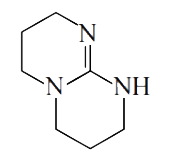The increasing order of pKa for the following phenols is
(A) 2,4 -Dinitrophenol
(B) 4-Nitrophenol
(C) 2,4,5 -Trimethylphenol
(D) Phenol
(E) 3-Chlorophenol
(A), (E), (B), (D), (C)
(C), (E), (D), (B), (A)
(C), (D), (E), (B), (A)
(A), (B), (E), (D), (C)
The correct Answer is:D
To determine the increasing order of pKa for the given phenols, we need to analyze the acidity of each compound based on the substituents present on the phenolic ring. The acidity of phenols is influenced by the electron-withdrawing or electron-donating effects of the substituents.
1. Identify the Structures:
- (A) 2,4-Dinitrophenol: Contains two nitro groups (-NO2) at positions 2 and 4.
- (B) 4-Nitrophenol: Contains one nitro group at position 4.
- (C) 2,4,5-Trimethylphenol: Contains three methyl groups (-CH3) at positions 2, 4, and 5.
- (D) Phenol: Contains only the hydroxyl group (-OH).
- (E) 3-Chlorophenol: Contains one chloro group (-Cl) at position 3.
2. Assess the Effects of Substituents:
- Nitro groups (-NO2) are strong electron-withdrawing groups due to their -M (mesomeric) and -I (inductive) effects, which increase the acidity of phenols.
- Methyl groups (-CH3) are electron-donating groups through their +I effect, which decrease acidity.
- The chloro group (-Cl) has a -I effect but no significant -M effect when in the meta position.
3. Rank the Acidity:
- 2,4-Dinitrophenol (A): Highest acidity due to two strong -NO2 groups.
- 4-Nitrophenol (B): Less acidic than 2,4-Dinitrophenol but more acidic than the others due to one -NO2 group.
- 3-Chlorophenol (E): Moderately acidic due to the -Cl group, which has a -I effect.
- Phenol (D): Less acidic than 3-Chlorophenol as it has no electron-withdrawing substituents.
- 2,4,5-Trimethylphenol (C): Least acidic due to three -CH3 groups, which decrease acidity.
4. Order of Acidity (Ka):
- The order of acidity from highest to lowest is:
- 2,4-Dinitrophenol (A) > 4-Nitrophenol (B) > 3-Chlorophenol (E) > Phenol (D) > 2,4,5-Trimethylphenol (C)
5. Convert to pKa Order:
- Since pKa is inversely related to acidity (higher acidity corresponds to lower pKa), the increasing order of pKa is:
- 2,4,5-Trimethylphenol (C) < Phenol (D) < 3-Chlorophenol (E) < 4-Nitrophenol (B) < 2,4-Dinitrophenol (A)
Final Answer:
The increasing order of pKa for the given phenols is:
C < D < E < B < A
- (A) 2,4-Dinitrophenol: Contains two nitro groups (-NO2) at positions 2 and 4.
- (B) 4-Nitrophenol: Contains one nitro group at position 4.
- (C) 2,4,5-Trimethylphenol: Contains three methyl groups (-CH3) at positions 2, 4, and 5.
- (D) Phenol: Contains only the hydroxyl group (-OH).
- (E) 3-Chlorophenol: Contains one chloro group (-Cl) at position 3.
- Nitro groups (-NO2) are strong electron-withdrawing groups due to their -M (mesomeric) and -I (inductive) effects, which increase the acidity of phenols.
- Methyl groups (-CH3) are electron-donating groups through their +I effect, which decrease acidity.
- The chloro group (-Cl) has a -I effect but no significant -M effect when in the meta position.
- 2,4-Dinitrophenol (A): Highest acidity due to two strong -NO2 groups.
- 4-Nitrophenol (B): Less acidic than 2,4-Dinitrophenol but more acidic than the others due to one -NO2 group.
- 3-Chlorophenol (E): Moderately acidic due to the -Cl group, which has a -I effect.
- Phenol (D): Less acidic than 3-Chlorophenol as it has no electron-withdrawing substituents.
- 2,4,5-Trimethylphenol (C): Least acidic due to three -CH3 groups, which decrease acidity.
- The order of acidity from highest to lowest is:
- 2,4-Dinitrophenol (A) > 4-Nitrophenol (B) > 3-Chlorophenol (E) > Phenol (D) > 2,4,5-Trimethylphenol (C)
- Since pKa is inversely related to acidity (higher acidity corresponds to lower pKa), the increasing order of pKa is:
- 2,4,5-Trimethylphenol (C) < Phenol (D) < 3-Chlorophenol (E) < 4-Nitrophenol (B) < 2,4-Dinitrophenol (A)
The increasing order of pKa for the given phenols is:
C < D < E < B < A
Topper's Solved these Questions
Similar Questions
Knowledge Check
- Question 1 - Select One
Arrange the following compounds in increasing order of their acidic strength:
(i) m-nitrophenol (ii) m-cresol
(iii) phenol (iv) m-chlorophenolAii<iii<iv<iBiii<ii<I<ivCii<iv<iii<iDii<iii<I<iv - Question 2 - Select One
The correct order of acid strength of the following compounds
A. Phenol
B. p-Cresol
C. m-Nitrophenol ltBrgt D. p-Nitrophenol.AC>B>A>DBD>C>A>BCB>D>A>CDA>B>D>C
Arrange the following compounds in increasing order of their acidic strength :
Propan -1-ol 2, 4, 6-trinitrophenol, 3-nitrophenol, 3, 5-dinitrophenol, phenol, 4-methylphenol.View SolutionWhat is the correct increasing order of acidic strength in the following :
(i) Phenol (ii) p-cresol (iii) p-nitrophenol (iv) o-nitrophenol ?View SolutionArrange the following compounds in the increasing order of their acidic strength:
(i) m-Nitrophenol (ii) m-Cresol
(iii) Phenol (iv) m-ChlorophenolView SolutionPredict the stronger acid from the following pairs :
(a) Phenol and o-cresol
(b) p-Nitrophenol and m-Nitrophenol
(c) Phenol and cyclohexanol.View SolutionArrange the following compounds in increasing order of their acid strength: Propan-1-ol, 2,4,6-trinitrophenol, 3-nitrophenol, 3,5-dinitrophenol, phenol, 4-methylphenol.
View SolutionPredict which is stronger acid in each of the following pairs :
(a) Phenol or cyclohexanol (b) Phenol or p-nitrophenol
(c) p-Nitrophenol or p-chlorophenol (d) 2,4, 6-Trinitrophenol or 2, 4-dinitrophenol
(e) p-Cyanophenol or phenol (f) (CH3)2CHOHor(CF3)2CHOH
(g) Phenol or benzyl alcoholView Solution


